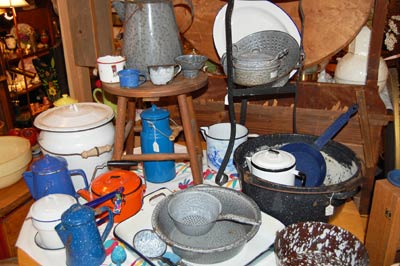Speaking of Antiquing – September 2014
I’ll bet most of you reading this article will have at least one piece of graniteware in your possession. You may have a white dinner plate with red trim under one of your houseplants; perhaps you have a black speckled roasting pan in your garage waiting for Thanksgiving; a large black canner being used now for putting up your fruits and vegetables; or one of those blue speckled dinner plates or bowls that are stowed away with your camping gear.
Graniteware, also known as Enamelware, Agate ware, or Granite ironware, is quite prolific, and is still on the market today. Vintage Graniteware can be a lot of fun to collect as it is still available and easily found and is one collectable that can be quite affordable, or very expensive. Rare pieces such as butter churns or “end of day” pieces can fetch high dollars.
Graniteware has been in existence since the 1700’s in Germany. It found its way to the U.S. in the mid-1800’s and quickly became the alternative to heavy cast iron cookware, winning medals in the Philadelphia World’s Fair.
Attractive and inexpensive, it was sold through Sears & Roebuck and was a favorite among farm and rural families. Enamel coating on the steel made items easy to clean and hard to rust. It had a high tolerance for heat and cold and users were told to grease-up items not used often to avoid rusting.
Graniteware was produced in many colors and as the years passed, each period had its own style and color, some more popular than others. Common colors were blue, red, brown, green and later, yellow. These colors were quite popular as they brightened up a home.
Design was applied to the enamelware while it was still wet. A piece of paper was spread thin with an oxidized pattern on top of it. Once the paper dried, it fell off and the design was ingrained in the enamelware. This process gave the appearance of granite, thus becoming graniteware. Designs were speckled or mottled.
Some manufacturers would re-dip the items after the original color or design did not ‘take’. These pieces are called ‘end of day’ pieces as it was done to finish off a batch at the end of a work shift in the factory. Collectors do not usually collect by brand names, as in other kitchenware, but rather for its color, shape or style.
Collectable pieces may include buckets, chamber pots, water pots, tea pots, cooking pots, cups, plates, spoons, muffin tins, trays, bowls, colanders, coffee pots, spoon racks, dippers, and more. Older pieces are riveted, or seamed, and are heavier than items made after WWII. If you tap a piece on the side and it sounds ‘tinny’ it was probably made in the 1970’s.
Here at Pickety Place, we carry quite a selection of Graniteware spanning many generations and look forward to seeing you soon!

 Margaret Barns is co-owner of Pickety Place Antiques & Collectibles located at 130 N. 4th Street in Jacksonville. LIKE them on
Margaret Barns is co-owner of Pickety Place Antiques & Collectibles located at 130 N. 4th Street in Jacksonville. LIKE them on